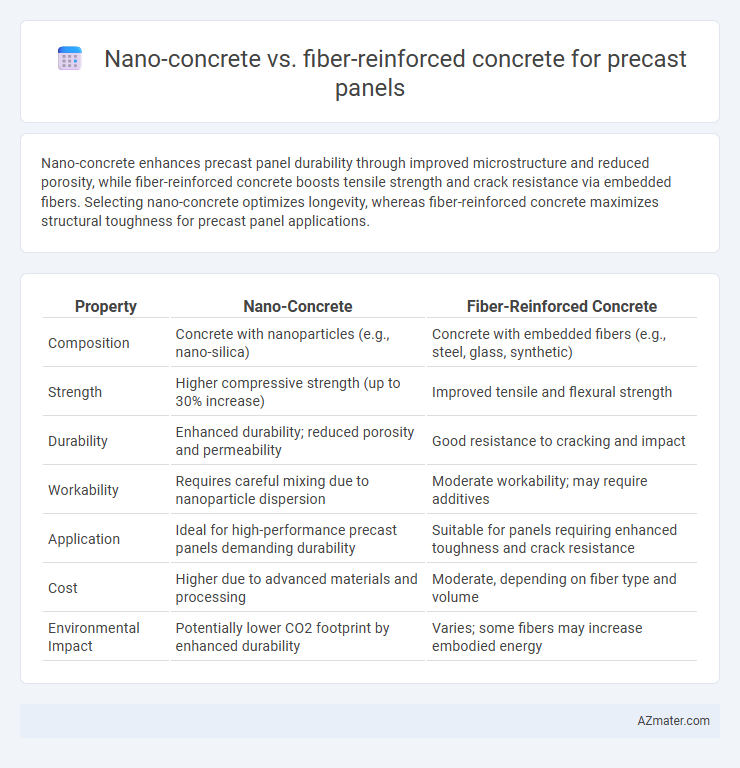Nano-concrete enhances precast panel durability through improved microstructure and reduced porosity, while fiber-reinforced concrete boosts tensile strength and crack resistance via embedded fibers. Selecting nano-concrete optimizes longevity, whereas fiber-reinforced concrete maximizes structural toughness for precast panel applications.
Table of Comparison
| Property | Nano-Concrete | Fiber-Reinforced Concrete |
|---|---|---|
| Composition | Concrete with nanoparticles (e.g., nano-silica) | Concrete with embedded fibers (e.g., steel, glass, synthetic) |
| Strength | Higher compressive strength (up to 30% increase) | Improved tensile and flexural strength |
| Durability | Enhanced durability; reduced porosity and permeability | Good resistance to cracking and impact |
| Workability | Requires careful mixing due to nanoparticle dispersion | Moderate workability; may require additives |
| Application | Ideal for high-performance precast panels demanding durability | Suitable for panels requiring enhanced toughness and crack resistance |
| Cost | Higher due to advanced materials and processing | Moderate, depending on fiber type and volume |
| Environmental Impact | Potentially lower CO2 footprint by enhanced durability | Varies; some fibers may increase embodied energy |
Introduction: Nano-Concrete and Fiber-Reinforced Concrete in Precast Panels
Nano-concrete incorporates nanoparticles such as nano-silica to enhance the mechanical properties and durability of precast panels by improving cement hydration and pore structure. Fiber-reinforced concrete integrates synthetic or steel fibers to increase tensile strength, toughness, and crack resistance in precast elements. Both materials contribute to the development of high-performance precast panels, optimizing structural integrity and longevity in construction applications.
Material Composition: Nano-Additives vs Fiber Inclusions
Nano-concrete incorporates nano-additives such as nanosilica, titanium dioxide, and carbon nanotubes, which enhance the matrix's microstructure by refining pore distribution and increasing chemical reactivity, leading to superior strength and durability. In contrast, fiber-reinforced concrete relies on the inclusion of synthetic or steel fibers that improve tensile strength, crack resistance, and impact toughness through mechanical bridging effects within the composite. For precast panels, the choice between nano-additives and fiber inclusions depends on the required balance between enhanced material properties, ease of fabrication, and long-term performance under environmental stressors.
Mechanical Strength: Compressive and Flexural Performance
Nano-concrete exhibits superior compressive strength due to the enhanced particle packing and reduced porosity achieved by incorporating nanoparticles, resulting in increased density and durability of precast panels. Fiber-reinforced concrete significantly improves flexural performance by bridging cracks and providing tensile resistance through dispersed fibers, enhancing toughness and post-cracking behavior. Combining nanoparticles with fiber reinforcement can synergistically optimize both compressive and flexural strength in precast concrete panels, leading to improved mechanical performance and service life.
Durability and Longevity in Harsh Environments
Nano-concrete enhances durability and longevity of precast panels in harsh environments through its refined microstructure, which reduces permeability and improves resistance to chemical attacks. Fiber-reinforced concrete increases toughness and crack resistance by incorporating synthetic or steel fibers, which help control crack propagation and improve impact resistance under aggressive conditions. Both materials significantly extend service life, but nano-concrete excels in barrier properties, while fiber-reinforced concrete provides superior mechanical resilience.
Processing and Workability in Precast Applications
Nano-concrete exhibits enhanced processing benefits in precast panel applications due to its improved particle packing and reduced pore structure, resulting in higher density and strength with minimal water content. Fiber-reinforced concrete offers superior workability challenges due to fiber dispersion and alignment, affecting pumpability and mold filling, which necessitate specialized mixing techniques and equipment adjustments. Optimizing mix design in nano-concrete leads to faster setting times and reduced shrinkage, whereas fiber-reinforced mixes require careful balance to maintain workability without compromising fiber distribution or panel surface finish.
Crack Resistance and Shrinkage Control
Nano-concrete enhances crack resistance and shrinkage control in precast panels by improving the microstructure through nanoparticle additives, reducing porosity and micro-cracks formation. Fiber-reinforced concrete utilizes synthetic or steel fibers that distribute stress and inhibit crack propagation, significantly enhancing toughness and reducing shrinkage-induced cracking. Both materials optimize durability in precast panels, with nano-concrete offering superior shrinkage control due to its refined matrix, while fiber-reinforced concrete excels in resisting crack growth under tensile stress.
Cost Analysis: Material and Production Efficiency
Nano-concrete offers enhanced material properties at a higher initial cost due to advanced nanoparticles and specialized mixing processes, increasing production expenses in precast panel manufacturing. Fiber-reinforced concrete, utilizing steel or synthetic fibers, provides improved crack resistance with more moderate material costs and simpler production techniques, enabling better cost-efficiency for large-scale precast panel projects. The choice between nano-concrete and fiber-reinforced concrete depends on balancing upfront material investment against long-term performance and production scalability in precast panel applications.
Sustainability and Environmental Impact
Nano-concrete enhances precast panel sustainability by reducing cement usage through nanoparticle additives that improve strength and durability, leading to lower carbon emissions during production. Fiber-reinforced concrete contributes to environmental benefits by increasing toughness and crack resistance, thus extending panel lifespan and minimizing repair waste. Both materials support eco-friendly construction, yet nano-concrete offers greater potential for carbon footprint reduction due to its optimized material composition.
Case Studies: Real-World Precast Panel Projects
Case studies on nano-concrete in precast panels demonstrate enhanced durability and reduced microcracking, exemplified by projects like the Guangzhou Metro expansion, where nano-silica additives improved compressive strength by 25%. Fiber-reinforced concrete precast panels, used in the Interstate 35W Bridge reconstruction, showed superior tensile strength and impact resistance, reducing maintenance cycles by 30%. Comparative analyses reveal nano-concrete's benefits in nano-scale particle distribution for improved matrix density, while fiber-reinforced concrete excels in crack arresting and load transfer within structural elements.
Future Trends: Innovations in Advanced Concrete Technologies
Nano-concrete incorporates nanoparticles to enhance mechanical properties and durability, showing significant potential for lightweight, high-strength precast panels. Fiber-reinforced concrete improves crack resistance and toughness, with innovations focusing on hybrid fibers and smart fiber materials for self-sensing capabilities. Future trends emphasize combining nano-additives with advanced fiber composites to optimize performance, sustainability, and lifecycle management in precast panel construction.

Infographic: Nano-concrete vs Fiber-reinforced concrete for Precast panel
 azmater.com
azmater.com